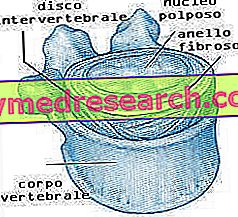Generality
The term hernia indicates the escape of a viscus (that is of an internal organ in a body cavity) or of part of it from the natural cavity that normally contains it.
Specifically, the term herniated disc indicates the leakage of material from the nucleus pulposus of the intervertebral disc, caused by the breakage of the fibers of the fibrous ring that form the disc wall.

Insights
Outline of Anatomy and PhysiologyIntervertebral discCauses of PainSymptomsDiscopathy Cervical Hernia Prevention Drugs for the treatment of herniated disc LaminectomyOutline of Anatomy and Physiology
The pulpy nucleus has a spherical shape and is formed by a gelatinous substance composed of about 88% water.
The fibrous ring is formed by a series of concentric fibrous bundles whose arrangement prevents the escape of the substance contained in the nucleus .
The spherical shape of the nucleus gives it a great mobility (it allows flexion-extension, inclination, sliding and rotation movements) but a scarce amplitude of movement. However, the summation of the movements of the various intervertebral discs allows the execution of large movements.
During the various stresses to the column the pulpy core acts as a real shock absorber distributing the loads to the fibrous ring. These continuous compressions cause the intervertebral disc to become dehydrated during the day, decreasing its thickness.
During the night, having no more significant pressure, the pulpy nuclei rehydrate and regain their initial thickness. For this reason we are taller in the morning than in the evening .
The efforts exerted on the intervertebral disc are considerable and for this reason over the years the disc undergoes aging processes .
Under the action of high pressure (for example, as a result of lifting an excessive weight), the substance of the nucleus pulposus can gradually migrate in various directions (following the yielding of the fibers of the fibrous ring). This spill is called herniation in medical terms and configures the etiological element of the herniated disc.
Causes of Pain
The close anatomical relationships between the intervertebral disc and nerve roots mean that the protrusion of the disc material mechanically compresses the adjacent nerve roots giving rise to pain.
According to the most recent theories, the pain is actually generated not by the direct contact between these two structures but by the escape from the discal nucleus of a set of substances that are very damaging to the nerve.
The stresses to the discs are all the greater as one gets closer to the sacred (the weight supported by the disc increases with the height of the overlying part), therefore the herniation of the disc is a very rare event at the level of the dorsal vertebrae, quite rare in the tract cervical and frequent in the lumbar tract.
The most frequent causes of the appearance of a herniated disc are: excessive loads, incorrect lifting of the loads, incorrect body postures and postures, vertebral lesions, muscular and ligamentous tissue deficiencies.
Symptoms
To learn more: Herniated Disc Symptoms
The herniated disc located in the lumbar region typically manifests as sciatica, ie with pain along the buttock, leg and foot.
When the hernia is instead localized in the cervical area, the patient typically suffers from cervical brachialgia, that is, from a pain that radiates from the cervical region along the arm and shoulder.
Prevention
Disc hernia prevention is based on the following points:
- maintenance of a good muscle tone, in particular of those muscles that doctors recognize as "core", that is the functional part of our body given by the set of abdominal, oblique, lumbar and paravertebral muscles.
- stretching to improve the flexibility of the lumbosacral tract and of the crural ischium muscles
- acquisition of the correct lifting technique (erect chest and flexed knees)
- correct eating habits, body weight control, regular physical activity, well-being-oriented lifestyle
See also: Importance of the abdominal muscles in the prevention of low back pain
FUNCTIONAL EXERCISES
Hernia and Gym
For further information: Herniated disc and bodybuilding
As we said in the introductory part, raising an excessive weight incorrectly represents the main cause of the appearance of the herniated disc.
In some cases, for example when lifting very high loads (90-100% of the ceiling) in exercises that particularly stress the lumbar vertebrae (squats, deadlifts, pushes with dumbbells, slow with barbell etc.) it can be useful to use a belt of containment .

In addition, a belt that is too narrow decreases the risk of herniated discs but considerably increases that of inguinal hernia due to the strong intra-abdominal pressures that are created.



